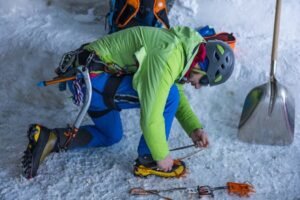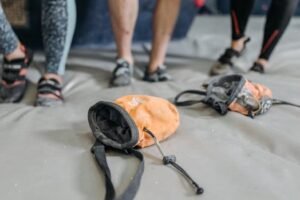Rock Climbing in Spain: Some of The Best Spots From a Local's Guide to Adventure
Spain is a rock climbing paradise, offering a diverse range of landscapes that cater to both the novice and the seasoned climber. Having grown up amidst these stunning terrains, I’ve been fortunate to explore some of the most breathtaking and challenging spots that this country has to offer. From the enchanting boulder fields of Albarracín, which me and my friends had the pleasure to discover, to the rugged beauty of La Pedriza, each location offers its own unique charm and climbing opportunities. Join me as I take you on a journey through Spain’s premier climbing destinations, including the summer havens of Rodellar and Cavaliers, and the iconic cliffs of El Chorro. Whether you’re planning a climbing adventure or just dreaming of one, this guide will equip you with all the insights you need to experience the best of rock climbing in Spain.
Table of Contents
ToggleIntroduction to Rock Climbing in Spain
Spain offers an unparalleled rock climbing experience, with its diverse landscapes and rich climbing culture. This section explores why Spain has become a mecca for climbers worldwide.
A Climber's Paradise
Spain’s varied terrain provides a playground for climbers of all levels. From towering limestone cliffs to challenging boulders, the country offers a wide range of climbing experiences.
The Mediterranean climate ensures ideal conditions for most of the year, making it possible to climb in different regions during various seasons. This versatility is a major draw for climbers seeking year-round adventures.
Spain’s climbing community is welcoming and vibrant, adding a social dimension to the sport. Many areas have well-established routes and a supportive network of local climbers and guides.
Why Spain is Ideal
Spain’s climbing appeal lies in its unique combination of natural beauty, accessibility, and climbing diversity. The country boasts over 4,000 crags and countless bouldering sites, offering something for everyone.
The infrastructure supporting climbing in Spain is well-developed. Many areas have detailed guidebooks, established campsites, and climbing shops nearby, making logistics easier for visiting climbers.
But rock climbing in Spain is not the only appeal, also spanish culture, with its relaxed pace and emphasis on outdoor living, complements the climbing lifestyle perfectly. After a day on the rocks, climbers can enjoy local cuisine and the warm hospitality of Spanish towns and villages.
Top Climbing Destinations
Spain’s climbing destinations are renowned worldwide. This section highlights some of the most popular and iconic spots for rock climbing enthusiasts.
Bouldering in Albarrazin
Albarrazin, located in the province of Teruel, is a bouldering paradise. Its unique red sandstone formations offer a variety of challenges for climbers of all levels.
The area features thousands of problems spread across several sectors, each with its own character. From delicate slab climbs to powerful overhangs, Albarrazin has it all and makes it one of the best spots for rock climbing in Spain.

The town of Albarrazin itself is a medieval gem, providing a picturesque backdrop to your climbing adventures. Its narrow streets and ancient walls offer a unique cultural experience between climbing sessions.
La Pedriza Climbing Adventures
La Pedriza, situated in the Sierra de Guadarrama, is famous for its granite domes and walls. This area offers a mix of traditional and sport climbing routes.
The unique rock formations in La Pedriza create challenging friction climbs and intricate crack systems. Climbers can test their skills on everything from single-pitch sport routes to multi-pitch traditional climbs.
La Pedriza’s proximity to Madrid makes it a popular weekend destination for local climbers. Despite this, its vast expanse means you can always find solitude and new challenges.

If you’re planning a rock climbing adventure in Spain, hiring a reputable and experienced climbing guide can take your experience to the next level. La Pedriza Guides is a trusted and professional guiding service that offers expert support not only in the breathtaking granite formations of La Pedriza but also in climbing areas all over Spain. Whether you’re a total beginner or an advanced climber looking to tackle new challenges, their team can assess your level and tailor the routes to match your skills and goals. Safety is always a top priority, and having a knowledgeable guide allows you to climb with confidence while learning more about the techniques and the terrain. Let La Pedriza Guides handle the planning, so you can focus on enjoying Spain’s epic rock climbing scene to the fullest.
Discover Rodellar Climbing
Another of my favorite places for rock climbing in Spain is Rodellar, nestled in the Sierra de Guara, is renowned for its limestone cliffs and caves. This area is a sport climbing haven, offering routes for intermediate to advanced climbers.
The distinctive tufa formations in Rodellar provide unique climbing experiences. Climbers can enjoy long, overhanging routes that require endurance and technical skill.
The area’s natural beauty, with its clear rivers and lush vegetation, adds to the appeal of climbing in Rodellar. Many climbers combine their trips with other outdoor activities like hiking and swimming.
Winter Climbs at El Chorro
El Chorro, located in Andalusia, is a prime winter climbing destination for rock climbing in Spain. Its southern location and sunny disposition make it perfect for escaping colder climates.
The area offers a mix of sport and traditional climbing routes on high-quality limestone. El Chorro is famous for its multi-pitch routes and the iconic Caminito del Rey, a walkway pinned along the steep walls of a narrow gorge.
Winter temperatures in El Chorro are mild, typically ranging from 10-20°C (50-68°F), providing ideal climbing conditions. The cooler temperatures allow for longer climbing sessions and better friction on the rock.

Planning Your Climbing Trip
Proper planning is key to a successful climbing trip in Spain. This section covers essential travel tips and gear recommendations.
Travel Tips for Spain
When planning your climbing trip to Spain, consider the following tips:
- Research the best season for your chosen destination.
- Book accommodations in advance, especially during peak seasons.
- Rent a car for easier access to climbing areas.
- Learn basic Spanish phrases to communicate with locals.
- Respect local customs and climbing ethics.
Many climbing areas in Spain are located near small towns or villages. These can offer authentic experiences and cheaper accommodation options compared to larger cities.
Check online forums and guidebooks for the most up-to-date information on access, route conditions, and local regulations.
Essential Gear for Spain's Terrain
Packing the right gear is crucial for a successful climbing trip in Spain. Here’s a list of essentials:
- Climbing shoes suitable for limestone and granite
- A variety of quickdraws for sport climbing
- A 70m rope (60m minimum) for longer routes
- Plenty of chalk for hot conditions
- Sun protection (hat, sunscreen, sunglasses)
- A lightweight rain jacket for unexpected showers
For bouldering trips, don’t forget to pack a crash pad. Many areas in Spain, like Albarrazin, require multiple pads for safe landings.
Consider the specific requirements of your chosen climbing area. Some locations may need additional gear like trad climbing equipment or multi-pitch essentials.
Embracing Spain's Climbing Culture
Immersing yourself in Spain’s climbing culture can greatly enrich your experience. This section explores how to connect with local climbers and respect the environment.
Connecting with Local Climbers
Rock climbing in Spain is also about interacting with other climbers, because Spain’s climbing community is known for its friendliness and openness to visitors. Engaging with local climbers can provide valuable insights and enhance your trip.
Visit local climbing shops or cafes frequented by climbers to meet people and get current information about the area. Many regions have climbing clubs or groups that welcome visitors to join their outings.
Online platforms and social media groups dedicated to climbing in Spain can be great resources for connecting with other climbers and finding partners.
Preserving Natural Sites
Responsible climbing is crucial for preserving Spain’s beautiful natural sites for future generations. Follow these guidelines:
- Stick to established trails and climbing routes
- Pack out all trash, including organic waste
- Respect local flora and fauna
- Avoid making noise in sensitive areas
- Support local conservation efforts

Many climbing areas in Spain are part of protected natural parks. Familiarize yourself with local regulations and obtain any necessary permits before climbing.
By respecting the environment and local communities, we ensure that Spain’s climbing areas remain accessible and beautiful for years to come.
Action Sports Equipment Blog Post List
- Best Football Boots Without Laces in 2025: Clean Strikes & Comfort
- Top 5 Football Drills at Home to Improve Your Skills
- The Best Climbing Training Plan
- What Is a Bouldering Crash Pad and Why You Still Need to Spot Your Friends
- Why Intermittent Fasting Works And Why Zero Calorie Drinks Are So Important
- The Best Supplements for Muscle Growth That Have Changed My Fitness Journey
- Padel Tennis Court Size: Understanding the Dimensions and Rules of the Game
- Most Popular Climbing Chalk Bag
- Beginner’s Guide to Choosing the Perfect Rock Climbing Harness in 2025
- How to Chose the Best Padel Rackets
- The Ultimate Guide to Choosing the Best Padel Shoes: A Comparison of Top Amazon Picks
- 10 Fitness Motivation Quotes to Ignite Your Workout Fire: Stay Inspired and Empowered
- Find your best freestyle football ball
- Starting Your Running Journey? Here's How to Pick the Best Running Shoes for Beginners
- The Best Folding Treadmills for Home
- Football GPS Tracker





